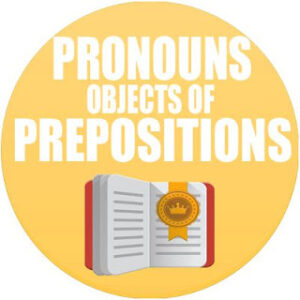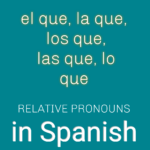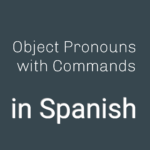Learning the Spanish Grammar | Lessons
Grammar 1
- Gender and Nouns in Spanish: Importance of Gender Agreement
 Gender and Nouns in Spanish: Understanding the Importance of Gender Agreement Gender agreement plays a significant role in the Spanish language, where every noun is assigned either a masculine or feminine gender. Mastering gender agreement is essential for effective communication in Spanish. In this article, we will delve deeper into the concept of gender in… Read more: Gender and Nouns in Spanish: Importance of Gender Agreement
Gender and Nouns in Spanish: Understanding the Importance of Gender Agreement Gender agreement plays a significant role in the Spanish language, where every noun is assigned either a masculine or feminine gender. Mastering gender agreement is essential for effective communication in Spanish. In this article, we will delve deeper into the concept of gender in… Read more: Gender and Nouns in Spanish: Importance of Gender Agreement - Spanish Transitional Words and Phrases
 What are some Spanish transitional words and phrases? This lesson covers some Spanish transitional words and phrases. There are enough here that you might want to bookmark the page to refer back yo it several times until you remember most of these. Now, since we have had a few lessons, we continue the page… Read more: Spanish Transitional Words and Phrases
What are some Spanish transitional words and phrases? This lesson covers some Spanish transitional words and phrases. There are enough here that you might want to bookmark the page to refer back yo it several times until you remember most of these. Now, since we have had a few lessons, we continue the page… Read more: Spanish Transitional Words and Phrases - Spanish Prepositions List
 What is the Spanish prepositions list? Let’s find out what is the Spanish prepositions list?. En esta lección vamos a estudiar algunas de las preposiciones más comunes del idioma Español. a = to, at, by means of Nosotros vamos a la escuela. (We are going to the school.) Ellos llegaron a las 10:00. (They… Read more: Spanish Prepositions List
What is the Spanish prepositions list? Let’s find out what is the Spanish prepositions list?. En esta lección vamos a estudiar algunas de las preposiciones más comunes del idioma Español. a = to, at, by means of Nosotros vamos a la escuela. (We are going to the school.) Ellos llegaron a las 10:00. (They… Read more: Spanish Prepositions List - Adverbs Of Frequency and Time in Spanish
 What are the adverbs of frequency and time in Spanish? It’s time to study the adverbs of frequency and time in Spanish. En esta lección de español vamos a estudiar algunos adverbios de tiempo. (In this Spanish lesson we are going to study some adverbs of time.) Vamos a ver Ahora (Now) Examples:… Read more: Adverbs Of Frequency and Time in Spanish
What are the adverbs of frequency and time in Spanish? It’s time to study the adverbs of frequency and time in Spanish. En esta lección de español vamos a estudiar algunos adverbios de tiempo. (In this Spanish lesson we are going to study some adverbs of time.) Vamos a ver Ahora (Now) Examples:… Read more: Adverbs Of Frequency and Time in Spanish - Adverbs of Mode in Spanish
 What are some adverbs of mode in Spanish? How and when to use the adverbs of mode in Spanish? Hola, ¿cómo están?…En esta lección de español vamos a estudiar algunos adverbios de modo. (In this Spanish lesson we are going to study some adverbs… Read more: Adverbs of Mode in Spanish
What are some adverbs of mode in Spanish? How and when to use the adverbs of mode in Spanish? Hola, ¿cómo están?…En esta lección de español vamos a estudiar algunos adverbios de modo. (In this Spanish lesson we are going to study some adverbs… Read more: Adverbs of Mode in Spanish - Adverbs of Place in Spanish
 What is the adverb for place in Spanish? How and when to use the adverbs of place in Spanish?. En esta lección de español vamos a estudiar algunos adverbios de lugar. (In this Spanish lesson we are going to study some adverbs of place.) Vamos a ver: Aquí / Acá (Here, near the person… Read more: Adverbs of Place in Spanish
What is the adverb for place in Spanish? How and when to use the adverbs of place in Spanish?. En esta lección de español vamos a estudiar algunos adverbios de lugar. (In this Spanish lesson we are going to study some adverbs of place.) Vamos a ver: Aquí / Acá (Here, near the person… Read more: Adverbs of Place in Spanish - Gerund and Present Progressive in Spanish
 How to use gerund and Present Progressive in Spanish? Let’s learn about the gerund and present progressive in Spanish. El Gerundio en Español (The Gerund and Present Progressive in Spanish) The Gerund (gerundio) is a form of the verb that ends in -ando (for the infinitives ending in ar) or -iendo (for the infinitives… Read more: Gerund and Present Progressive in Spanish
How to use gerund and Present Progressive in Spanish? Let’s learn about the gerund and present progressive in Spanish. El Gerundio en Español (The Gerund and Present Progressive in Spanish) The Gerund (gerundio) is a form of the verb that ends in -ando (for the infinitives ending in ar) or -iendo (for the infinitives… Read more: Gerund and Present Progressive in Spanish - Hay in Spanish
 How to say hay in Spanish? It’s time to study “How to translate hay in Spanish?”, this is a verb form that expresses the idea of existence. When you use it with singular nouns it means there is, and when it is used with plural nouns it means there are . Hay (there… Read more: Hay in Spanish
How to say hay in Spanish? It’s time to study “How to translate hay in Spanish?”, this is a verb form that expresses the idea of existence. When you use it with singular nouns it means there is, and when it is used with plural nouns it means there are . Hay (there… Read more: Hay in Spanish - Spanish Expressions with Gustaría
 What are some Spanish expressions with gustaría? How to translate Spanish expressions with gustaría?. Buenos días o buenas tardes o buenas noches (good morning or good afternoon or good night). ¿Cómo están ustedes?… (How are you all). Today we are going to study “Gustaría” which means “would like”, a handy expression to know. Let’s… Read more: Spanish Expressions with Gustaría
What are some Spanish expressions with gustaría? How to translate Spanish expressions with gustaría?. Buenos días o buenas tardes o buenas noches (good morning or good afternoon or good night). ¿Cómo están ustedes?… (How are you all). Today we are going to study “Gustaría” which means “would like”, a handy expression to know. Let’s… Read more: Spanish Expressions with Gustaría - Useful Spanish Expressions
 What are the most useful Spanish expressions? How to translate useful Spanish expressions?. ¡Hola mis amigos! The verbs deber (should or ought to), necesitar (to need), and the impersonal expressions hay que (one must) and es necesario (it is necessary) are very useful for forming quick expressions when speaking in Spanish. Here are some examples:… Read more: Useful Spanish Expressions
What are the most useful Spanish expressions? How to translate useful Spanish expressions?. ¡Hola mis amigos! The verbs deber (should or ought to), necesitar (to need), and the impersonal expressions hay que (one must) and es necesario (it is necessary) are very useful for forming quick expressions when speaking in Spanish. Here are some examples:… Read more: Useful Spanish Expressions - Expressing Possession in Spanish
 Expressing Possession in Spanish | How do you show possession in Spanish? It’s time to study: expressing possession in Spanish. Hola mis estudiantes de Español (Hello my Spanish students) ¿Listos? (Ready?) The easiest way to express possession in Spanish is by using the verb “tener” (to have) – we know this right?: yo… Read more: Expressing Possession in Spanish
Expressing Possession in Spanish | How do you show possession in Spanish? It’s time to study: expressing possession in Spanish. Hola mis estudiantes de Español (Hello my Spanish students) ¿Listos? (Ready?) The easiest way to express possession in Spanish is by using the verb “tener” (to have) – we know this right?: yo… Read more: Expressing Possession in Spanish - Demonstrative Adjectives in Spanish
 How many demonstrative adjectives in Spanish? Let’s talk about the demonstrative adjectives in Spanish. Well, now that we have covered Past, Present and Future Tenses in Spanish we are ready for some easy and fun stuff. My theory always has been that you need first to understand these three basic tenses so you could… Read more: Demonstrative Adjectives in Spanish
How many demonstrative adjectives in Spanish? Let’s talk about the demonstrative adjectives in Spanish. Well, now that we have covered Past, Present and Future Tenses in Spanish we are ready for some easy and fun stuff. My theory always has been that you need first to understand these three basic tenses so you could… Read more: Demonstrative Adjectives in Spanish - Articles, Nouns and Adjectives in Spanish
 Articles, Nouns and Adjectives in Spanish | Lesson Let’s talk about the articles, nouns and adjectives in Spanish. The Articles The definite article: English has only one definite article: “The” In Spanish the definite articles are: el, la, los, las: el carro (the car) la casa (the house) los carros (the cars) las casas (the… Read more: Articles, Nouns and Adjectives in Spanish
Articles, Nouns and Adjectives in Spanish | Lesson Let’s talk about the articles, nouns and adjectives in Spanish. The Articles The definite article: English has only one definite article: “The” In Spanish the definite articles are: el, la, los, las: el carro (the car) la casa (the house) los carros (the cars) las casas (the… Read more: Articles, Nouns and Adjectives in Spanish - Irregular Verbs in the Present Tense in Spanish
 Irregular Verbs in the Present Tense | Lesson What are the irregular verbs in the Present tense?. The verbs Ir (to go), Dar (to give) and Estar (to be) are irregular in the present tense. However, the only irregularity is in the first person yo. All other forms are the same forms of a regular… Read more: Irregular Verbs in the Present Tense in Spanish
Irregular Verbs in the Present Tense | Lesson What are the irregular verbs in the Present tense?. The verbs Ir (to go), Dar (to give) and Estar (to be) are irregular in the present tense. However, the only irregularity is in the first person yo. All other forms are the same forms of a regular… Read more: Irregular Verbs in the Present Tense in Spanish - Spanish Expressions and Useful Words
 Which are the most common Spanish expressions and useful words? Let’s talk about some popular Spanish expressions and useful words. (Prior to beginning this lesson, visit our Spanish pronunciation guide to learn basic pronunciation, and be sure to refer back to it as necessary. There is also a link to it from the site map.) The… Read more: Spanish Expressions and Useful Words
Which are the most common Spanish expressions and useful words? Let’s talk about some popular Spanish expressions and useful words. (Prior to beginning this lesson, visit our Spanish pronunciation guide to learn basic pronunciation, and be sure to refer back to it as necessary. There is also a link to it from the site map.) The… Read more: Spanish Expressions and Useful Words - Spanish Irregular Past Tense
 What is the Spanish Irregular Past Tense? Spanish Irregular verbs in the Preterite or Past tense. The verb DAR (to give) is irregular in the Preterite as it is in the Present tense too (Do you remember?..). It is irregular in the past because despite having an “ar” ending it is conjugated as a verb… Read more: Spanish Irregular Past Tense
What is the Spanish Irregular Past Tense? Spanish Irregular verbs in the Preterite or Past tense. The verb DAR (to give) is irregular in the Preterite as it is in the Present tense too (Do you remember?..). It is irregular in the past because despite having an “ar” ending it is conjugated as a verb… Read more: Spanish Irregular Past Tense - Verb To Be in Spanish (Ser VS Estar)
 What are the verbs to be in Spanish? It’s time to study the verb to be in Spanish. Let’s find out the difference between ser vs estar in Spanish. How to translate the verb to be in Spanish? Los Pronombres Personales (Subject Pronouns) Singular Yo ………… I Tú ………….You (informal) Usted ……..You (formal) Él ……………He… Read more: Verb To Be in Spanish (Ser VS Estar)
What are the verbs to be in Spanish? It’s time to study the verb to be in Spanish. Let’s find out the difference between ser vs estar in Spanish. How to translate the verb to be in Spanish? Los Pronombres Personales (Subject Pronouns) Singular Yo ………… I Tú ………….You (informal) Usted ……..You (formal) Él ……………He… Read more: Verb To Be in Spanish (Ser VS Estar) - Spanish Verb Gustar
 What does the Spanish verb Gustar mean in Spanish? Let’s talk about the Spanish verb gustar. ¡Hola mis amigos! (Hello my friends), ¿Cómo están? (How are you). Today we are going to study verb GUSTAR (to like). GUSTAR is what I call “a peculiar verb” because GUSTAR is usually used with the indirect object pronouns… Read more: Spanish Verb Gustar
What does the Spanish verb Gustar mean in Spanish? Let’s talk about the Spanish verb gustar. ¡Hola mis amigos! (Hello my friends), ¿Cómo están? (How are you). Today we are going to study verb GUSTAR (to like). GUSTAR is what I call “a peculiar verb” because GUSTAR is usually used with the indirect object pronouns… Read more: Spanish Verb Gustar - Spanish Verbs Tener and Ir
 Spanish Verbs Tener and Ir in English: When learning Spanish, it’s important to understand the verbs “tener” (to have) and “ir” (to go) as they are commonly used in various contexts. Below are the meanings and conjugations of these crucial verbs: 1. Tener (to have):– Yo tengo: I have– Tú tienes: You have (informal)– Él/Ella/Usted… Read more: Spanish Verbs Tener and Ir
Spanish Verbs Tener and Ir in English: When learning Spanish, it’s important to understand the verbs “tener” (to have) and “ir” (to go) as they are commonly used in various contexts. Below are the meanings and conjugations of these crucial verbs: 1. Tener (to have):– Yo tengo: I have– Tú tienes: You have (informal)– Él/Ella/Usted… Read more: Spanish Verbs Tener and Ir - Infinitive Form in Spanish
 When do you use the infinitive form in Spanish? Let’s talk about the infinitive form in Spanish. Vamos a empezar. (Let’s get started). The infinitive is the “base form” of the verb, before the verb is conjugated. For example: to speak, to eat, to live are English verbs in the infinitive form; to + verb… Read more: Infinitive Form in Spanish
When do you use the infinitive form in Spanish? Let’s talk about the infinitive form in Spanish. Vamos a empezar. (Let’s get started). The infinitive is the “base form” of the verb, before the verb is conjugated. For example: to speak, to eat, to live are English verbs in the infinitive form; to + verb… Read more: Infinitive Form in Spanish - Using Some Common Spanish Verbs
 What are some common Spanish verbs? The most common Spanish verbs in Spanish. In this lesson I want to share some easy-to-follow examples of how to use common Spanish verbs. These are verbs I’ve been reviewing with students in my tutoring. They can get you speaking Spanish right away. Aquí vamos! (Here we go): 1-Verbs… Read more: Using Some Common Spanish Verbs
What are some common Spanish verbs? The most common Spanish verbs in Spanish. In this lesson I want to share some easy-to-follow examples of how to use common Spanish verbs. These are verbs I’ve been reviewing with students in my tutoring. They can get you speaking Spanish right away. Aquí vamos! (Here we go): 1-Verbs… Read more: Using Some Common Spanish Verbs - Personal Pronouns in Spanish
 What are the 12 personal pronouns in Spanish? Study the personal pronouns in Spanish. Learn to apply Spanish grammar rules with online lessons. Learn more about helpful tips on how to improve your language. Yo(I)(Singular) Tú(You)(Singular)(Informal) Usted (You)(Singular)(Formal) Él (He)(Singular) Ella(She)(Singular) … Read more: Personal Pronouns in Spanish
What are the 12 personal pronouns in Spanish? Study the personal pronouns in Spanish. Learn to apply Spanish grammar rules with online lessons. Learn more about helpful tips on how to improve your language. Yo(I)(Singular) Tú(You)(Singular)(Informal) Usted (You)(Singular)(Formal) Él (He)(Singular) Ella(She)(Singular) … Read more: Personal Pronouns in Spanish - Prepositional Phrases in Spanish
 What are the 13 prepositional phrases? Study the prepositional phrases in Spanish. Learn to apply Spanish grammar rules with online lessons. Learn more about helpful tips on how to improve your language. Sobre de/Abajo de(Above/Under) Lejos de(Far from) Fuera de (Outside) Entre (Between) Encima de(On… Read more: Prepositional Phrases in Spanish
What are the 13 prepositional phrases? Study the prepositional phrases in Spanish. Learn to apply Spanish grammar rules with online lessons. Learn more about helpful tips on how to improve your language. Sobre de/Abajo de(Above/Under) Lejos de(Far from) Fuera de (Outside) Entre (Between) Encima de(On… Read more: Prepositional Phrases in Spanish - Inequality, equality and superlatives in SpanishInequality, equality and superlatives | Rules Read about inequality, equality and superlatives in Spanish. Learn to apply Spanish grammar rules with online lessons. Learn more about helpful tips on how to improve your language. Note: Inequality is expressed by using one of the following formula: más (menos) + adjective + quemás (menos) + adverb +… Read more: Inequality, equality and superlatives in Spanish
- Ir a, Acabar de, Volver a + Infinitive in Spanish
 Ir a, Acabar de, Volver a | Rules How do you use Acabar de infinitive? Read about how to use ir a, acabar de, volver a in Spanish. Learn to apply Spanish grammar rules with online lessons. Learn more about helpful tips on how to improve your language. Many useful expressions are formed by combining… Read more: Ir a, Acabar de, Volver a + Infinitive in Spanish
Ir a, Acabar de, Volver a | Rules How do you use Acabar de infinitive? Read about how to use ir a, acabar de, volver a in Spanish. Learn to apply Spanish grammar rules with online lessons. Learn more about helpful tips on how to improve your language. Many useful expressions are formed by combining… Read more: Ir a, Acabar de, Volver a + Infinitive in Spanish - Irregular Verbs in Spanish: Estar, Ir, Dar
 Irregular Verbs in Spanish Read about how to use the irregular verbs in Spanish. Learn to apply Spanish grammar rules with online lessons. Learn more about helpful tips on how to improve your language. Note: Notice that “ir” and “dar” follow the same pattern as “estar”; they are irregular in the first person singular (yo).… Read more: Irregular Verbs in Spanish: Estar, Ir, Dar
Irregular Verbs in Spanish Read about how to use the irregular verbs in Spanish. Learn to apply Spanish grammar rules with online lessons. Learn more about helpful tips on how to improve your language. Note: Notice that “ir” and “dar” follow the same pattern as “estar”; they are irregular in the first person singular (yo).… Read more: Irregular Verbs in Spanish: Estar, Ir, Dar - Stem Changing Verbs Spanish
 What are the types of stem changing verbs? Stem Changing Verbs: OU:E Remember, there are three types of infinitives: -ar, -er, -ir. Infinitives are made up of two parts: the ending and the stem. hablar – habl (stem) + ar (ending) comer – com (stem) + er (ending) vivir – viv (stem) + ir (ending) With regular verbs, the stem… Read more: Stem Changing Verbs Spanish
What are the types of stem changing verbs? Stem Changing Verbs: OU:E Remember, there are three types of infinitives: -ar, -er, -ir. Infinitives are made up of two parts: the ending and the stem. hablar – habl (stem) + ar (ending) comer – com (stem) + er (ending) vivir – viv (stem) + ir (ending) With regular verbs, the stem… Read more: Stem Changing Verbs Spanish - Al and Del in Spanish – Contractions
 When to use al and del in Spanish? Let’s find out when to use the contractions al and del in Spanish. Note: When “a” or “de” precedes the definite article “el”, the two words combine to form a contraction. a + el = al de + el = del e.g. Vamos al estadio – Vamos… Read more: Al and Del in Spanish – Contractions
When to use al and del in Spanish? Let’s find out when to use the contractions al and del in Spanish. Note: When “a” or “de” precedes the definite article “el”, the two words combine to form a contraction. a + el = al de + el = del e.g. Vamos al estadio – Vamos… Read more: Al and Del in Spanish – Contractions - What is A in Spanish?
 This article will tell you what is A in Spanish. A is a word in Spanish, a letter of the alphabet and a preposition. When to use A in Spanish? Note: In Spanish, when the direct object is a person, it is preceded by the preposition “a”. Tip: This word has no English translation. e.g.… Read more: What is A in Spanish?
This article will tell you what is A in Spanish. A is a word in Spanish, a letter of the alphabet and a preposition. When to use A in Spanish? Note: In Spanish, when the direct object is a person, it is preceded by the preposition “a”. Tip: This word has no English translation. e.g.… Read more: What is A in Spanish? - When do you use tener in Spanish?
 How do you use tener in Spanish? Let’s find out when do you use the verb tener in Spanish. There are many idiomatic expressions that use the verb “tener”. e.g. “tener ___ años” Incorrect: (to have _____ years) Correct: (to be _____ years old) “tener frío” Incorrect: (to have cold) Correct: to be cold “tener… Read more: When do you use tener in Spanish?
How do you use tener in Spanish? Let’s find out when do you use the verb tener in Spanish. There are many idiomatic expressions that use the verb “tener”. e.g. “tener ___ años” Incorrect: (to have _____ years) Correct: (to be _____ years old) “tener frío” Incorrect: (to have cold) Correct: to be cold “tener… Read more: When do you use tener in Spanish? - Possessive Adjective in Spanish
 What is a possessive adjective in grammar? In this lesson you are going to learn the possessive adjective in Spanish. Possessive adjectives are used to show ownership. Masculine Forms: Singular Masculine – Plural Masculine Yo (I)-(My): Mi – Mis Tú (You)(Informal)-(Your): Tu – Tus Usted (You)(Formal)-(Your): Su – Sus Él/Ella(He/She)-(His/Her): Su– Sus Nosotros(as)We)-(Our): Nuestro – Nuestros Vosotros(as)(You)(Informal)-(Your): Vuestro– Vuestros Ustedes(You)(Formal)-(Your): Su – Sus Ellos(as)(They)- (Their): Su– Sus Feminine Forms: Singular Feminine – Plural… Read more: Possessive Adjective in Spanish
What is a possessive adjective in grammar? In this lesson you are going to learn the possessive adjective in Spanish. Possessive adjectives are used to show ownership. Masculine Forms: Singular Masculine – Plural Masculine Yo (I)-(My): Mi – Mis Tú (You)(Informal)-(Your): Tu – Tus Usted (You)(Formal)-(Your): Su – Sus Él/Ella(He/She)-(His/Her): Su– Sus Nosotros(as)We)-(Our): Nuestro – Nuestros Vosotros(as)(You)(Informal)-(Your): Vuestro– Vuestros Ustedes(You)(Formal)-(Your): Su – Sus Ellos(as)(They)- (Their): Su– Sus Feminine Forms: Singular Feminine – Plural… Read more: Possessive Adjective in Spanish - Spanish Negation
 What is a negation in Spanish? In this lesson you are going to learn how to use the Spanish negation. Note: To make a sentence negative, place the word “no” before the verb. Affirmative–Negative Nosotros hablamos Español (We speak Spanish) – Nosotros no hablamos Español (We don’t speak Spanish) Ella está aquí (She is here) – Ella no está aquí (She is… Read more: Spanish Negation
What is a negation in Spanish? In this lesson you are going to learn how to use the Spanish negation. Note: To make a sentence negative, place the word “no” before the verb. Affirmative–Negative Nosotros hablamos Español (We speak Spanish) – Nosotros no hablamos Español (We don’t speak Spanish) Ella está aquí (She is here) – Ella no está aquí (She is… Read more: Spanish Negation - Difference Between Ser and Estar in Spanish
 In this lesson you are going to learn the difference between ser and estar in Spanish. Ser and estar can both be translated as “to be” In Spanish, a different verb is used to express “to be” depending on whether the speaker intends to address a condition or an essential quality. Subject – Estar – Ser (to… Read more: Difference Between Ser and Estar in Spanish
In this lesson you are going to learn the difference between ser and estar in Spanish. Ser and estar can both be translated as “to be” In Spanish, a different verb is used to express “to be” depending on whether the speaker intends to address a condition or an essential quality. Subject – Estar – Ser (to… Read more: Difference Between Ser and Estar in Spanish - Rules of Adjectives in Spanish
 What are the rules for Spanish adjectives? Study the rules of adjectives in Spanish. Learn Spanish grammar with online lessons. Vocabulary translation from English to Spanish with words and phrases. Rules of Adjectives in Spanish Most adjectives change form, depending upon whether the word they modify is masculine or feminine. Notice the difference between “the… Read more: Rules of Adjectives in Spanish
What are the rules for Spanish adjectives? Study the rules of adjectives in Spanish. Learn Spanish grammar with online lessons. Vocabulary translation from English to Spanish with words and phrases. Rules of Adjectives in Spanish Most adjectives change form, depending upon whether the word they modify is masculine or feminine. Notice the difference between “the… Read more: Rules of Adjectives in Spanish - Hay in Spanish Translation
 How do you use hay in Spanish translation? In this lesson you are going to learn how to use hay in Spanish translation. The verb form “hay” has two meanings: hay (for singular) – there is hay (for plural) – there are How to translate hay in Spanish? e.g. Hay muchos papeles en el escritorio. –… Read more: Hay in Spanish Translation
How do you use hay in Spanish translation? In this lesson you are going to learn how to use hay in Spanish translation. The verb form “hay” has two meanings: hay (for singular) – there is hay (for plural) – there are How to translate hay in Spanish? e.g. Hay muchos papeles en el escritorio. –… Read more: Hay in Spanish Translation - Definite Article in Spanish
 What is an example of a definite article in Spanish? Study how to use the definite article in Spanish. Learn Spanish grammar with online lessons. Vocabulary translation from English to Spanish with words and phrases. Note: Feminine singular nouns that begin with an emphasized “a” or “ha” use the masculine form of the article. e.g. el aire –… Read more: Definite Article in Spanish
What is an example of a definite article in Spanish? Study how to use the definite article in Spanish. Learn Spanish grammar with online lessons. Vocabulary translation from English to Spanish with words and phrases. Note: Feminine singular nouns that begin with an emphasized “a” or “ha” use the masculine form of the article. e.g. el aire –… Read more: Definite Article in Spanish - Definite and Indefinite Articles in Spanish
 What are the definite and indefinite articles in Spanish? Study how to use the definite and indefinite articles in Spanish. Learn Spanish grammar with online lessons. Vocabulary translation from English to Spanish with words and phrases. Definite and Indefinite Articles (Artículos Definido e Indefinido) The difference between definite articles and indefinite articles can be… Read more: Definite and Indefinite Articles in Spanish
What are the definite and indefinite articles in Spanish? Study how to use the definite and indefinite articles in Spanish. Learn Spanish grammar with online lessons. Vocabulary translation from English to Spanish with words and phrases. Definite and Indefinite Articles (Artículos Definido e Indefinido) The difference between definite articles and indefinite articles can be… Read more: Definite and Indefinite Articles in Spanish - Spanish Compound Nouns
 Study the Spanish compound nouns. Learn Spanish grammar with online lessons. Vocabulary translation from English to Spanish with words and phrases. Does Spanish have compound words? | Spanish Compound Nouns Compound Nouns English Abrelatas Can opener Aguardiente Schnapps Altoparlante Loudspeaker Anteojos Glasses Autoempleo Self-employment Autoestéreo Car stereo Casaquinta Fifth House Cascanueces Nutcracker Caza recompensas Bounty… Read more: Spanish Compound Nouns
Study the Spanish compound nouns. Learn Spanish grammar with online lessons. Vocabulary translation from English to Spanish with words and phrases. Does Spanish have compound words? | Spanish Compound Nouns Compound Nouns English Abrelatas Can opener Aguardiente Schnapps Altoparlante Loudspeaker Anteojos Glasses Autoempleo Self-employment Autoestéreo Car stereo Casaquinta Fifth House Cascanueces Nutcracker Caza recompensas Bounty… Read more: Spanish Compound Nouns - Singular and Plural Nouns in Spanish
 How do you explain Singular and Plural in Spanish? Study how to use the singular and plural nouns in Spanish. Learn Spanish grammar with online lessons. Vocabulary translation from English to Spanish with words and phrases. Singular and Plural Nouns Note: If a noun ends in a vowel, make it plural by adding “-s”. Singular – Plural… Read more: Singular and Plural Nouns in Spanish
How do you explain Singular and Plural in Spanish? Study how to use the singular and plural nouns in Spanish. Learn Spanish grammar with online lessons. Vocabulary translation from English to Spanish with words and phrases. Singular and Plural Nouns Note: If a noun ends in a vowel, make it plural by adding “-s”. Singular – Plural… Read more: Singular and Plural Nouns in Spanish - Numbers and Nouns in Spanish
 How to use numbers and nouns in Spanish? Study how to use the numbers and nouns in Spanish. Learn Spanish grammar with online lessons. Vocabulary translation from English to Spanish with words and phrases. Note: The number “one” changes from “uno” to “un” before a masculine noun. un libro – one book – uno libro… Read more: Numbers and Nouns in Spanish
How to use numbers and nouns in Spanish? Study how to use the numbers and nouns in Spanish. Learn Spanish grammar with online lessons. Vocabulary translation from English to Spanish with words and phrases. Note: The number “one” changes from “uno” to “un” before a masculine noun. un libro – one book – uno libro… Read more: Numbers and Nouns in Spanish - Gender of Nouns in Spanish
 Does Spanish language have gender of nouns? Study how to use the gender of nouns in Spanish. Learn Spanish grammar with online lessons. Vocabulary translation from English to Spanish with words and phrases. A noun is a part of speech that denotes a person, animal, place, thing, or idea. In Spanish, all nouns are… Read more: Gender of Nouns in Spanish
Does Spanish language have gender of nouns? Study how to use the gender of nouns in Spanish. Learn Spanish grammar with online lessons. Vocabulary translation from English to Spanish with words and phrases. A noun is a part of speech that denotes a person, animal, place, thing, or idea. In Spanish, all nouns are… Read more: Gender of Nouns in Spanish
Grammar 2
- When to Use Reflexive Verbs in Spanish
 When to Use Reflexive Verbs in Spanish? Let’s learn how and when to use reflexive verbs in the Spanish language. Using Me, Te, Se, Nos, Os in Spanish Note: A reflexive verb in Spanish is when the subject and the object are the same. I clean myself. subject: I verb: clean object: myself Since the… Read more: When to Use Reflexive Verbs in Spanish
When to Use Reflexive Verbs in Spanish? Let’s learn how and when to use reflexive verbs in the Spanish language. Using Me, Te, Se, Nos, Os in Spanish Note: A reflexive verb in Spanish is when the subject and the object are the same. I clean myself. subject: I verb: clean object: myself Since the… Read more: When to Use Reflexive Verbs in Spanish - Possessive Pronouns in Spanish
 Possessive Pronouns in Spanish Translation Learn how to use possessive pronouns in Spanish. The possessive pronouns are similar to the possessive adjectives, but they are normally used with a definite article. – Singular Feminine – Plural Feminine mine– la mía– las mías yours (informal)– la tuya– las tuyas his/hers– la suya– las suyas yours (formal)– la suya– las suyas ours– la nuestra– las… Read more: Possessive Pronouns in Spanish
Possessive Pronouns in Spanish Translation Learn how to use possessive pronouns in Spanish. The possessive pronouns are similar to the possessive adjectives, but they are normally used with a definite article. – Singular Feminine – Plural Feminine mine– la mía– las mías yours (informal)– la tuya– las tuyas his/hers– la suya– las suyas yours (formal)– la suya– las suyas ours– la nuestra– las… Read more: Possessive Pronouns in Spanish - Demonstrative Adjectives in Spanish Translation
 What is a demonstrative adjective in Spanish? Learn how to use demonstrative adjectives in Spanish translation. In this lesson, we will discuss demonstratives of two types: demonstrative adjectives and demonstrative pronouns. Adjective: describes a noun Pronoun: takes the place of a noun The same is true in Spanish. Ella escribe este libro.- She writes this book. (adjective)… Read more: Demonstrative Adjectives in Spanish Translation
What is a demonstrative adjective in Spanish? Learn how to use demonstrative adjectives in Spanish translation. In this lesson, we will discuss demonstratives of two types: demonstrative adjectives and demonstrative pronouns. Adjective: describes a noun Pronoun: takes the place of a noun The same is true in Spanish. Ella escribe este libro.- She writes this book. (adjective)… Read more: Demonstrative Adjectives in Spanish Translation - Irregular Comparatives in Spanish
 How to use the irregular comparatives in Spanish? Learn how to use the irregular comparatives in Spanish. The following adjectives have irregular forms for the comparative and the superlative: Adjective: bueno (good) Comparative: mejor (better) Superlative: el/la mejor (the best) Adjective: malo (bad) Comparative: peor (worse) Superlative: el/la peor (the worst) Adjective: grande (big) Comparative: mayor (older; greater) Superlative: el/la mayor (the oldest; the… Read more: Irregular Comparatives in Spanish
How to use the irregular comparatives in Spanish? Learn how to use the irregular comparatives in Spanish. The following adjectives have irregular forms for the comparative and the superlative: Adjective: bueno (good) Comparative: mejor (better) Superlative: el/la mejor (the best) Adjective: malo (bad) Comparative: peor (worse) Superlative: el/la peor (the worst) Adjective: grande (big) Comparative: mayor (older; greater) Superlative: el/la mayor (the oldest; the… Read more: Irregular Comparatives in Spanish - Hacer Time Expressions in Spanish
 How Do You Use Hacer Time Expressions in Spanish? Learn how to use hacer time expressions in Spanish. Note: The verb “hacer” can be used in a number of ways to indicate the length of time an action has been taking place. The first way uses the formula: Hace + time + que + Present tense form… Read more: Hacer Time Expressions in Spanish
How Do You Use Hacer Time Expressions in Spanish? Learn how to use hacer time expressions in Spanish. Note: The verb “hacer” can be used in a number of ways to indicate the length of time an action has been taking place. The first way uses the formula: Hace + time + que + Present tense form… Read more: Hacer Time Expressions in Spanish - Me Gusta in Spanish
 Me Gusta in Spanish Translation Learn how to use me gusta in Spanish. The verb “gustar” requires use of the indirect object pronouns. Note: The only forms of “gustar” you will use are “gusta” and “gustan” e.g. Me gusta la fresa. I like the strawberry Te gusta el programa. You like the program. Nos gusta el color azul. We… Read more: Me Gusta in Spanish
Me Gusta in Spanish Translation Learn how to use me gusta in Spanish. The verb “gustar” requires use of the indirect object pronouns. Note: The only forms of “gustar” you will use are “gusta” and “gustan” e.g. Me gusta la fresa. I like the strawberry Te gusta el programa. You like the program. Nos gusta el color azul. We… Read more: Me Gusta in Spanish - Direct and Indirect Object in Spanish
 How to Use the Spanish Direct and Indirect Object Pronouns Together? Learn how to use direct and indirect object in Spanish. Here are the direct object pronouns and the indirect object pronouns Direct Object Pronouns/ Indirect Object Pronouns/ English Equivalent me/ me/ me te/ te/ you (familiar) lo, la/ le/ him, her, it, you (formal) nos/ nos/ us os/ os/ you-all (informal) los, las/ les/ them, you-all (formal) Note:… Read more: Direct and Indirect Object in Spanish
How to Use the Spanish Direct and Indirect Object Pronouns Together? Learn how to use direct and indirect object in Spanish. Here are the direct object pronouns and the indirect object pronouns Direct Object Pronouns/ Indirect Object Pronouns/ English Equivalent me/ me/ me te/ te/ you (familiar) lo, la/ le/ him, her, it, you (formal) nos/ nos/ us os/ os/ you-all (informal) los, las/ les/ them, you-all (formal) Note:… Read more: Direct and Indirect Object in Spanish - Spanish Indirect Object Pronouns
 What are the Spanish Indirect Object Pronouns? Learn how to use the Spanish indirect object pronouns. The indirect object tells us where the direct object is going. Indirect object pronouns 1 The indirect object answers the question “to whom?” or “for whom” the action of the verb is performed. When a pronoun takes the place… Read more: Spanish Indirect Object Pronouns
What are the Spanish Indirect Object Pronouns? Learn how to use the Spanish indirect object pronouns. The indirect object tells us where the direct object is going. Indirect object pronouns 1 The indirect object answers the question “to whom?” or “for whom” the action of the verb is performed. When a pronoun takes the place… Read more: Spanish Indirect Object Pronouns - Direct Object Pronouns Spanish
 What are the direct object pronouns in Spanish? Learn how to use the direct object pronouns in Spanish. The object that directly receives the action of the verb is called the direct object. The direct object can also be a person. Direct object pronouns in Spanish 1 The direct object answers the question “what?” or “whom?”… Read more: Direct Object Pronouns Spanish
What are the direct object pronouns in Spanish? Learn how to use the direct object pronouns in Spanish. The object that directly receives the action of the verb is called the direct object. The direct object can also be a person. Direct object pronouns in Spanish 1 The direct object answers the question “what?” or “whom?”… Read more: Direct Object Pronouns Spanish - Spanish Prepositional Pronouns
 What are Spanish prepositional pronouns? Learn how to use Spanish Prepositional Pronouns. A pronoun is a word that is used instead of the name of a person or thing. When the pronoun acts as the object of a preposition, a different set of pronouns is used. Subject – Obj. Prep. Pronouns Yo (I) – mí Tú (You)(Informal) – ti Él/Ella(He/She)… Read more: Spanish Prepositional Pronouns
What are Spanish prepositional pronouns? Learn how to use Spanish Prepositional Pronouns. A pronoun is a word that is used instead of the name of a person or thing. When the pronoun acts as the object of a preposition, a different set of pronouns is used. Subject – Obj. Prep. Pronouns Yo (I) – mí Tú (You)(Informal) – ti Él/Ella(He/She)… Read more: Spanish Prepositional Pronouns
Grammar 3
- Nosotros Commands in Spanish
 How do you form nosotros commands in Spanish? Learn how to use nosotros commands in Spanish. Note: “Nosotros” commands are used when the speaker isincluded, and are used to express the idea “let’s + verb”. To form these commands, use the “nosotros” form of the Present subjunctive. Escribamos la carta – Let’s write the letter. Pintemos las paredes.… Read more: Nosotros Commands in Spanish
How do you form nosotros commands in Spanish? Learn how to use nosotros commands in Spanish. Note: “Nosotros” commands are used when the speaker isincluded, and are used to express the idea “let’s + verb”. To form these commands, use the “nosotros” form of the Present subjunctive. Escribamos la carta – Let’s write the letter. Pintemos las paredes.… Read more: Nosotros Commands in Spanish - Vosotros Commands in Spanish
 How do you use Vosotros commands in Spanish? Learn how to use vosotros commands in Spanish. Note: The affirmative “vosotros” command is formed by simply replacing the final “r” of the infinitive with “d” Comprad (vosotros) el libro. – (You-all) Buy the book Escribid (vosotros) la carta. – (You-all) Write the letter. Comprad (vosotros) los libros.- (You-all) Buy… Read more: Vosotros Commands in Spanish
How do you use Vosotros commands in Spanish? Learn how to use vosotros commands in Spanish. Note: The affirmative “vosotros” command is formed by simply replacing the final “r” of the infinitive with “d” Comprad (vosotros) el libro. – (You-all) Buy the book Escribid (vosotros) la carta. – (You-all) Write the letter. Comprad (vosotros) los libros.- (You-all) Buy… Read more: Vosotros Commands in Spanish - Irregular Commands: Tú in Spanish
 Which of the Following Tú Commands is Irregular? Learn how to use the irregular commands: tú in Spanish. The following eight verbs have irregular informal commands in the affirmative: decir – di (to say) salir – sal(to get out) hacer – haz(to do) ser – sé (to be) ir – ve(to go) tener – ten(to have) poner… Read more: Irregular Commands: Tú in Spanish
Which of the Following Tú Commands is Irregular? Learn how to use the irregular commands: tú in Spanish. The following eight verbs have irregular informal commands in the affirmative: decir – di (to say) salir – sal(to get out) hacer – haz(to do) ser – sé (to be) ir – ve(to go) tener – ten(to have) poner… Read more: Irregular Commands: Tú in Spanish - Informal Commands: Tú in Spanish
 What is the informal tú command? Learn how to use the informal commmands: tú in Spanish. Start learning basic Spanish words and phrases with online lessons. Note: The affirmative informal “tú” commands are formed the same way as the Present indicative “Usted” form: (hablar + a = habla)(comer + e = come)(escribir + e = escribe) Note: Be… Read more: Informal Commands: Tú in Spanish
What is the informal tú command? Learn how to use the informal commmands: tú in Spanish. Start learning basic Spanish words and phrases with online lessons. Note: The affirmative informal “tú” commands are formed the same way as the Present indicative “Usted” form: (hablar + a = habla)(comer + e = come)(escribir + e = escribe) Note: Be… Read more: Informal Commands: Tú in Spanish - Formal Commands in Spanish
 How do you give formal commands in Spanish? Formal commands in Spanish are used when ordering or telling someone to do something. This is often referred to as the “imperative” form of the verb. Haga Ud. el desayuno.- Make (You) breakfast. Escriba Ud. la carta. – Write (You) the letter. Salgan Uds. primero. – (You-all) Come out first… Read more: Formal Commands in Spanish
How do you give formal commands in Spanish? Formal commands in Spanish are used when ordering or telling someone to do something. This is often referred to as the “imperative” form of the verb. Haga Ud. el desayuno.- Make (You) breakfast. Escriba Ud. la carta. – Write (You) the letter. Salgan Uds. primero. – (You-all) Come out first… Read more: Formal Commands in Spanish - Relative Adjectives in Spanish
 What are Relative Adjectives in Spanish? Note: We include the relative adjectives in Spanish “cuyo, cuya, cuyos, cuyas” in this discussion because it relates the owner to that which is owned, as does the English “whose”. e.g La gata, cuyo dueño es mi hermano, es muy peligrosa – The cat, whose owner is my brother, is very dangerous… Read more: Relative Adjectives in Spanish
What are Relative Adjectives in Spanish? Note: We include the relative adjectives in Spanish “cuyo, cuya, cuyos, cuyas” in this discussion because it relates the owner to that which is owned, as does the English “whose”. e.g La gata, cuyo dueño es mi hermano, es muy peligrosa – The cat, whose owner is my brother, is very dangerous… Read more: Relative Adjectives in Spanish - el que, la que, los que, las que, lo que in Spanish
 What are Relative Pronouns in Spanish?: el que, la que, los que, las que, lo que Note: The relative pronouns: (el que, la que, los que, las que, lo que) in Spanish are used to refer to both people and things. Note that there are four forms to accommodate singular and plural, masculine and feminine.… Read more: el que, la que, los que, las que, lo que in Spanish
What are Relative Pronouns in Spanish?: el que, la que, los que, las que, lo que Note: The relative pronouns: (el que, la que, los que, las que, lo que) in Spanish are used to refer to both people and things. Note that there are four forms to accommodate singular and plural, masculine and feminine.… Read more: el que, la que, los que, las que, lo que in Spanish - Relative Pronouns in Spanish
 Learn how and when to use the relative pronouns in Spanish. Qué, Quién: Relative Pronouns in Spanish Que: relative pronouns One way to view relative pronouns is to recognize that they combine two sentences that share a common noun. In the following examples, the common nouns are “butter” or “mantequilla”; “homework” or “tarea” e.g. ¿Dónde… Read more: Relative Pronouns in Spanish
Learn how and when to use the relative pronouns in Spanish. Qué, Quién: Relative Pronouns in Spanish Que: relative pronouns One way to view relative pronouns is to recognize that they combine two sentences that share a common noun. In the following examples, the common nouns are “butter” or “mantequilla”; “homework” or “tarea” e.g. ¿Dónde… Read more: Relative Pronouns in Spanish - Indirect Commands in Spanish
 What is an indirect command in Spanish? Learn how to use the indirect commands in Spanish. Note: When the command is given through a third party, indirect commands in Spanish are used. The form is “que + Present subjunctive” e.g. Que venga Rosa. – Let Rose come. Que vengan a las once – Have them come at… Read more: Indirect Commands in Spanish
What is an indirect command in Spanish? Learn how to use the indirect commands in Spanish. Note: When the command is given through a third party, indirect commands in Spanish are used. The form is “que + Present subjunctive” e.g. Que venga Rosa. – Let Rose come. Que vengan a las once – Have them come at… Read more: Indirect Commands in Spanish - Imperfect Subjunctive in Spanish
 What is the Imperfect Subjunctive in Spanish? The Imperfect tense of the subjunctive mood is used to express the same subjectivity as the Present subjunctive, but in the past. Imperfect Subjunctive in Spanish 1 To indicate an action in the past in the same situations where the subjunctive would be required in the Present: e.g.… Read more: Imperfect Subjunctive in Spanish
What is the Imperfect Subjunctive in Spanish? The Imperfect tense of the subjunctive mood is used to express the same subjectivity as the Present subjunctive, but in the past. Imperfect Subjunctive in Spanish 1 To indicate an action in the past in the same situations where the subjunctive would be required in the Present: e.g.… Read more: Imperfect Subjunctive in Spanish - Object Pronouns Commands in Spanish
 How Do You Use Object Pronouns with Commands in Spanish? Learn how to use the object pronouns with commands in Spanish. With all affirmative commands, the object pronouns are attached directly to the end of the imperative form of the verb. e.g. Hable usted del caso – Talk about the case Háblelo usted – Talk about the… Read more: Object Pronouns Commands in Spanish
How Do You Use Object Pronouns with Commands in Spanish? Learn how to use the object pronouns with commands in Spanish. With all affirmative commands, the object pronouns are attached directly to the end of the imperative form of the verb. e.g. Hable usted del caso – Talk about the case Háblelo usted – Talk about the… Read more: Object Pronouns Commands in Spanish - When Do You Use Subjunctive in Spanish
 Let’s learn how and when to use the subjunctive in Spanish. When do you use subjunctive in the Spanish language? | Subjunctive 1 The subjunctive is not a tense; rather, it is a mood. Tense refers to when an action takes place (Past, Present, Future), while mood merely reflects how the speaker feels about the action. Note: The… Read more: When Do You Use Subjunctive in Spanish
Let’s learn how and when to use the subjunctive in Spanish. When do you use subjunctive in the Spanish language? | Subjunctive 1 The subjunctive is not a tense; rather, it is a mood. Tense refers to when an action takes place (Past, Present, Future), while mood merely reflects how the speaker feels about the action. Note: The… Read more: When Do You Use Subjunctive in Spanish - Adverbs of Formation in Spanish
 How do you use to make an adverbs formation in Spanish? Learn how to use adverbs of formation in Spanish. Adverbs are words that describe, or modify, verbs, adjectives or other adverbs. Note:Most Spanish adverbs are formed by adding “-mente”to the feminine singular form of the adjective. This ending corresponds to -ly in English. English– Adjective– Fem. Form– Adverb clear,… Read more: Adverbs of Formation in Spanish
How do you use to make an adverbs formation in Spanish? Learn how to use adverbs of formation in Spanish. Adverbs are words that describe, or modify, verbs, adjectives or other adverbs. Note:Most Spanish adverbs are formed by adding “-mente”to the feminine singular form of the adjective. This ending corresponds to -ly in English. English– Adjective– Fem. Form– Adverb clear,… Read more: Adverbs of Formation in Spanish